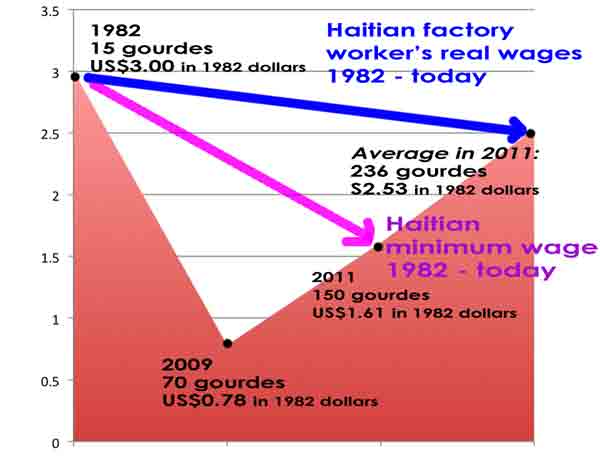Salaries in the “new” Haiti
1st of 7 articles
“I have a problem with my country. I’ve been working in factories here for 25 years, and I still don’t have my own house.”
– Evelyne Pierre-Pauli
Pierre-Paul, 50, doesn’t even rent a house. Before the January 12, 2010, earthquake, she and her three children rented two rooms for 10,000 gourdes (about US$250) a year. But the building was destroyed in the earthquake. Twenty-two months later they are still living under a tent, in one of the capital’s hundreds of squalid refugee camps.
Pierre-Paul’s average daily take-home wage is actually more than Haiti’s rock-bottom minimum.ii She earns about 225 gourdes or US$4.69 a day. But that doesn’t cover even half of what would be considered a family’s most basic expenses. Like all the other workers Haiti Grassroots Watch (HGW) surveyed, only some of Pierre-Paul’s children attend school, and the family rarely eats meat.
“When payday comes, you pay all the little debts you accumulated, and you don’t have anything left,” the worker told Haiti Grassroots Watch (HGW).
Pierre-Paul sews clothes for One World Apparel, a giant hanger-like factory owned by two-time failed presidential candidate Charles H. Baker. The cloth comes in duty-free, workers cut it up, stitch the pieces together, and the clothing – for K-Mart, Wal-Mart and for uniform supply companies – goes back out. The factory enjoys a number of tax benefits like a 15-year exemption on payroll taxes and no Value Added Tax, even though its not in a Free Trade Zone (FTZ), thanks to the Investment Code enacted during the truncated 2000-2004 mandate of President Jean-Bertrand Aristide.
Currently, about 29,000 workers, about 65 percent of them women, cut and sew in Haitian textile factories assembling clothes for Banana Republic, GAP, Hanes, Gildan Activewear, Levis, and dozens of other well-known labels. But if the Michel Martelly government, the Interim Haiti Recovery Commission (IHRC), the US State Department, the World Bank, George Soros, and a host of others involved in Haiti’s “reconstruction” see their visions realized, there will soon be 200,000 or even 500,000 assembly workers in FTZs and industrial parks all over the country. [See Why is Haiti “attractive”? Story #3]
That prospect doesn’t interest Pierre-Paul too much.

Pierre-Paul in her "house." Photo: HGW
One recent night, after a ten-hour workday, the slightly hunched sewing machine operator met with a journalist in one of her tent’s “rooms.” A plastic table and a few chairs are jammed up against the canvas walls. In the other “room” the worker has a bed where she and all her children sleep. Clothes are neatly piled in the corner. Pierre-Paul makes food – lots of spaghetti – on a charcoal fire outside.
“I don’t see any future in this for my children,” she commented.
Downwardly Mobile
That’s not surprising. Pierre-Paul’s wages have one-third less buying power than they did 25 years ago when she first began her factory career. Minimum wage has gone from US$3.00 in 1982 (in 1982 dollars) to 150 gourdesiii, which is about US$1.61 in 1982 dollars. Even taking into account Pierre-Paul’s slightly higher average wage, she still makes only US$2.53 in 1982 dollars.

Minimum wage in 1982, 2009 and today, compared with its real buying
power in 1982 US dollars. (During its investigation, HGW learned that
most workers today earn more than the minimum wage, but that the
salary remains less than it was in 1982.)
An in-depth study conducted by HGW with eight workers in the capital and from the country’s biggest FTZ – the Dominican-owned CODEVI park on the Haitian-Dominican Republican border – determined that the average worker wage is about 236 gourdes a day – that’s $2.53 in 1982 dollars. (Two factory owners, Baker and Clifford Apaid, confirmed that average.) According to HGW’s statistics, the average worker’s annual salary, including the traditional “thirteenth month,” would be about $153 a month or $1,989 per year.
HGW’s study also found that the average worker spends more than half of his or her wage just getting to work and back and eating lunch.
Averages of workers’ typical commute and lunch expenses
|
Expense |
Gourdes |
US dollars |
Percentage of a day’s wage |
|
Transportation to and from work |
30.62 g |
$0.76 |
13% |
|
Main meal of the day (at work) |
90 g |
$2.25 |
38% |
|
|
|
|
|
|
|
120.62 g |
$3.01 |
51% |
Transportation and food represent only a tiny percentage of a workers’ responsibilities. For example, the average worker surveyed supports over four people, three of them children. Average school fees carried for each worker, according to HGW’s study, come close to US$690 per family.
While HGW could not verify all of the figures, a recent study came up with an even higher numbers for transportation, school fees and other expenses. According to the AFL-CIO’s Solidarity Center, a “living wage” for an average factory-worker family with one wage-earner and two children should be about $749 per month – almost five times the current average assembly worker wage of $153 per month.
“This figure represents the actual cost of living and serves as a baseline for an appropriate minimum wage that will promote sustainable economic development,” the Solidarity Center noted in its March 3, 2011, report.
“The salary question is a veritable scandal,” economist Camille Chalmers told HGW in an interview. “The salary has gotten lower and lower, also. [Workers] get paid in gourdes but in fact [because almost half of food eaten in Haiti is imported], they consume in dollars.”


A worker at one of the CODEVI factories in Ouanaminthe. Photos: HGW
Pierre-Paul said she knows the salary is not enough.
“I don’t have any choice,” she explained. “My parents didn’t have me learn a skill, so when I was 25, and I didn’t know what else to do, I resigned myself to factory work.”
Pierre-Paul’s boss, factory owner Charles H. Baker, admits the salary is not “livable.”
“If a person is honest, it’s clear that it’s not enough,” Baker admitted. “If I could give a worker 1,000 gourdes a day, I’d pay that. But the conditions in Haiti don’t permit us to pay 1,000 gourdes.”
A glimpse into the life of a worker
Baker and other factory owners might claim they want to pay more than sweatshop wages but they have fought salary hikes and unions ever since they got into the game.
Under the Duvalier regime – when wages were actually higher than today – only the dictatorship-sanctioned “union” was allowed. Since then, owners have (so far) nearly crushed any organizing efforts.
Thanks to the hard work of the labor group Batay Ouvriye (Worker’s Struggle) and the courage of workers there, who endured threats, job losses and even beatings, over 3,000 laborers at the CODEVI park on the Haitian-Dominican border belong to a union. The union negotiates a collective contract for all the workers there.
This fall Batay Ouvriye and textile workers got a union going in the capital. On September 15, organizers announced the new, legally registered Textile and Clothing Workers Union (SOTA - Sendika Ouvriye Tekstil ak Abiman). In less than two weeks, however, five SOTA executive committee members had been fired, one of them from Baker’s One World Apparel.
Batay Ouvriye’s spokeswoman Yannick Etienne said the firings – which factory spokespeople said were for “violations,” were totally predictable. “It’s very coincidental that one week after the union is announced, five committee members are fired. They decapitated the union.”
Asked about the incident, Baker said his lawyer had advised him not to comment. But according to the Batay Ouvriye, workers were fired after handing out leaflets in the street, refusing to work overtime, and other actions which are completely guaranteed by Haitian law.
After a long investigation, on November 24, 2011, a United Nations organization revealed that the firings were not just. Better Work, an organization set up by the UN’s International Labor Organization, noted that:
“There is solid evidence showing that the representatives of SOTA were fired because they belong to a union” and recommended “the reintegration with back pay as a means of reparation” for the union members.
The September firings are only the latest in the three decades of repression and union-busting.
See Anti-union, pro-“race to the bottom” - Story #2
Return to the Introduction and the video
i. The names of this worker has been changed to protect their identity because, despite the fact that the Haitian Constitution recognizes the right of free speech, and the right for workers to organize, most workplaces are pervaded by fear due to the strong anti-union sentiment. All interviews took place in the spring and summer of 2011.
ii. Workers in assembly factories are paid a base salary with extra wages for extra work. This average is calculated on a typical two-week period, and was confirmed by the factory.
iii. Minimum wage in the assembly industry factories is 150 gourdes, due to pressure on the government by factory owners, with US government backing [see Story #2]. Minimum wage for all other sectors is 200 gourdes.

